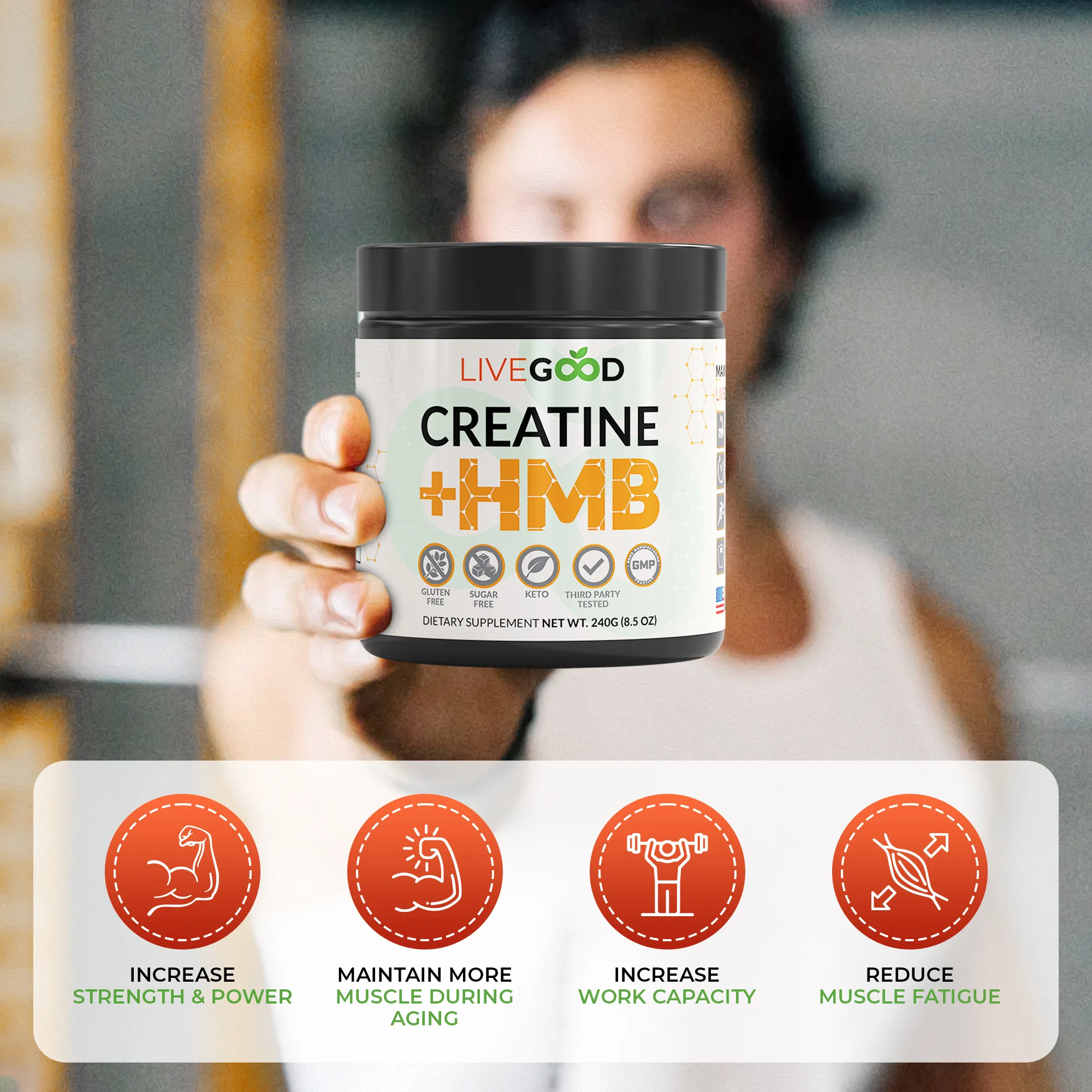Looking for stronger lifts without a puffy face or upset stomach? Livegood creatine + hmb review keeps it simple and science-backed. It breaks down how creatine and HMB work together, how to use them, and how to check for bloat or gut issues.
This helps lifters chasing PRs, busy parents training three to four days a week, runners who lift, and anyone who wants creatine recovery without drama. Here is a straight review with clear steps and real expectations.
You will learn how creatine monohydrate and HMB support strength, what to watch for in the gym, how to dose it, and how to judge value. Expect practical tips and a clean plan you can start today.
- Daily creatine monohydrate at 3 to 5 grams works for most.
- HMB near 3 grams per day can support muscle retention and recovery.
- Watch your own markers: lifts, morning weight, waist, comfort.
- Steady dosing, good hydration, and balanced sodium keep bloat low.
- Track for 2 to 4 weeks before calling it.
What Is LiveGood Creatine + HMB and How It Works for Strength and Recovery

Creatine monohydrate is a compound stored in muscle. It helps recycle ATP, the quick energy your body uses for heavy lifts and sprints. Daily use raises muscle creatine stores over time, which helps short burst power and volume.
HMB is a metabolite of leucine. It supports muscle repair and helps reduce breakdown from hard training. In plain terms, it helps you hold onto muscle and bounce back faster.
Together, creatine + HMB can support strength bumps and steadier training weeks. Think two extra clean reps on squats or finishing sprint repeats with less fade. During a cut, the combo may help protect muscle while calories sit lower.
Good fits:
- Beginners who want a simple start.
- Intermediate lifters who want strength without extra puff.
- Athletes in-season who need recovery support.
- Adults over 40 focused on muscle retention.
Limits:
- Diet quality, sleep, and a solid program move the needle most.
- Supplements fill gaps, they do not fix poor training or low protein.
- Individual response varies, so track your own results.
Creatine monohydrate and HMB explained in simple terms
- Creatine monohydrate: Helps muscles recycle energy fast. Useful for heavy lifts, quick jumps, and short sprints.
- HMB: Supports repair and reduces breakdown. Useful during hard blocks or fat loss phases.
Both are common in sports nutrition and count as natty creatine options. Quick win: train consistently, hit your protein, and take a daily dose.
Why combine creatine + HMB for lifters and athletes
Creatine boosts short burst power. HMB supports recovery and muscle retention. The result is simple synergy.
Possible benefits:
- Better last reps on bench or squats.
- Less drop-off from set to set.
- Less next-day soreness when volume climbs.
- Useful during a cut or in-season, when recovery time is tight.
Claims stay measured here. Some users feel clear benefits, others notice smaller changes. Track and decide.
Who should consider it, and who should skip it
Good candidates:
- Strength athletes and regular lifters.
- Team sport players with tight practice schedules.
- Adults 40 plus aiming to hold or build muscle.
- Beginners who want a trusted, simple start.
Consider skipping or ask a doctor first:
- People with known kidney issues.
- Anyone on medications that affect kidneys or hydration.
- Under 18 without parental and coach guidance.
- Pregnant or breastfeeding individuals.
Does It Deliver Strength Bumps Without the Bloat?
Judge results with a simple plan. Keep a training log for 2 to 4 weeks. Track top sets, total volume, rest times, and RPE. Add a few daily markers.
Daily checks:
- Morning body weight, after the bathroom, before food.
- Waist at the navel, same tape tension each time.
- Bloat score from 0 to 3 based on comfort and look.
What creatine bloat feels like:
- A mild jump on the scale in week one or two.
- Slight puffiness in the face or midsection.
- Some water held in the muscles.
Creatine monohydrate daily does not have to cause a puffy look. Steady dosing, solid hydration, and balanced sodium make a big difference.
In the gym, watch bar speed, between-set recovery, and next-day soreness. If strength and repeatability improve while waist stays steady, that is a good sign.
Everyone responds a bit differently. Trust your own markers before judging the product.
Week-by-week results: lifts, power, and endurance
Pick three to four key tests:
- Lifts: squat, bench, deadlift, or a key machine press or row.
- Power: jump height or a timed sprint.
- Endurance: repeated sprints, EMOM sets, or back-off volume.
What to look for:
- One to two extra reps at the same load.
- Same reps with a bit more weight.
- Slightly faster sprints with the same rest.
Creatine benefits build with time. Week two to four often shows more change than week one.
Bloat check: water weight, stomach feel, and comfort
Use simple tracking:
- Morning weight: small uptick is normal, large spikes are not.
- Waist line: if waist stays stable, extra weight is likely intramuscular water.
- Comfort note: rate 0 to 3 for bloat each morning.
Tips to reduce puffiness:
- Split the daily dose, morning and evening.
- Drink enough water. Aim for pale yellow urine.
- Take with a meal or shake.
- Keep sodium steady across days.
Many users can avoid the bloated look with a modest daily dose and good hydration.
Recovery and soreness: how it affects the next workout
Better creatine recovery often feels like:
- Less soreness the next day after big lifts.
- Steadier power across sets, less falloff.
- A quicker warm-up into working sets.
Log how the body feels 24 hours after hard sessions. Note sleep quality and daily steps. Protein intake and sleep still drive most recovery, so keep those tight.
Ingredients, Dosing, and How It Compares to Plain Creatine
Check the label for creatine monohydrate content and total HMB. Evidence-based ranges are clear. Creatine monohydrate daily at 3 to 5 grams is standard. HMB is often near 3 grams per day.
Loading is optional. A steady daily dose works well for most. If the stomach is sensitive, split doses and take with food.
How it compares to a basic natty creatine:
- Combo pick: simple, one scoop, with added recovery support.
- Plain creatine: saves money, easy to dose, proven on its own.
Mixability, flavor, and sweeteners vary by brand. Many unflavored powders mix best in a shake or with plenty of water. Pair with water or a protein shake based on taste.
Value check:
- Price per serving.
- Ingredient quality and transparency.
- How often you take it, daily or on training days only.
For more details on the specific product, see the page for LiveGood Creatine + HMB for strength gains.
Evidence-based dosing: creatine monohydrate daily and HMB
- Creatine monohydrate: 3 to 5 grams daily.
- HMB: about 3 grams per day, often split with meals.
Large loading phases can upset the stomach for some users. A simple daily dose with patience often works just as well in a few weeks. Follow the label directions and adjust timing for comfort.
Mixability, taste, and how to take it for best results
Use enough water and stir or shake well. Let it sit for a minute if needed. Some powders need a second stir.
Take it at a consistent time each day. With a meal or a shake can help comfort and make the habit stick. Timing matters less than taking it daily.
LiveGood vs basic creatine and other stacks
Combo benefits:
- One scoop, added recovery support, fewer moving parts.
Plain creatine benefits:
- Lower cost, flexible dosing, easy to pair with your own stack.
DIY stack, creatine plus HMB:
- More control over amounts, possibly cheaper if bought in bulk.
- Slightly more effort with two containers and measuring.
Pick based on budget, convenience, and how your body responds.
How to Use It Right: Timing, Stacks, Safety, and Quick FAQs

Daily use matters more than timing. Take it pre, post, or any consistent time. If doing a loading phase, keep it short and split doses to reduce stomach issues. If not loading, stay patient and let levels rise over two to four weeks.
Hydration and electrolytes help keep bloat low. Steady sodium intake and enough fluids are key.
Common side effects are mild, often stomach upset from big single doses or taking it on an empty stomach. Split doses, take with food, and use enough water to fix most issues.
Daily plan: when to take, with or without food, and loading
Simple plan:
- Pick a time, stick to it every day.
- Take with a meal or shake if your stomach is sensitive.
- Loading is optional. Many do great with one daily dose and patience.
- If loading, try smaller servings spread across the day for five days.
Smart stacks for muscle, fat loss, or game-day performance
Muscle gain:
- Creatine + HMB, whey or a protein-rich meal, progressive overload.
- Add carbs near training for better sessions.
Fat loss:
- Creatine + HMB for muscle retention, high protein diet, steps and strength work.
- Keep calories in check, keep lifting heavy enough to signal muscle.
Performance:
- Creatine + HMB, carbs before and after, good sleep.
- Add a simple electrolyte mix if you sweat hard.
Side effects, who should avoid it, and when to talk to a doctor
Common mild effects:
- Stomach upset if taken fast, on an empty stomach, or in large doses.
- Small water weight increase in the first weeks.
Solutions:
- Split the dose, take with food, drink more water.
Talk to a doctor first if:
- You have kidney disease or a related medical condition.
- You are pregnant or breastfeeding.
- You take medications that affect kidneys or hydration.
Creatine is widely studied and considered safe for healthy adults when used as directed.
Quick FAQs: bloating, cycling, missed doses, and travel
- Bloating: Not required. Steady daily dosing and hydration help keep it low.
- Cycling: Not needed for most users.
- Missed dose: Take the next one as normal, do not double up.
- Travel: Pre-portion servings in a small container and keep the daily habit.
Simple Tracking Sheet for 2 to 4 Weeks
Metric | What to Track | Goal After 2 to 4 Weeks |
|---|---|---|
Top Set Strength | Weight x reps on 3 key lifts | 1 to 2 more reps or small load |
Training Volume | Total hard sets per lift per week | Same workload feels easier |
Sprint or Power Test | Time or jump height | Slightly faster or higher |
Morning Body Weight | Daily average across a week | Small uptick is fine |
Waist at Navel | Same tape tension, once per morning | Stable or within 0.25 inch |
Bloat Score | 0 none, 1 mild, 2 moderate, 3 high | Mostly 0 to 1 |
Recovery Note | Soreness, sleep, steps | Less soreness, better sessions |
Conclusion
The verdict of this Livegood creatine + hmb review is simple. The creatine plus HMB combo offers an easy path to steady strength and better recovery, with a low risk of bloat when dosing is daily and hydration is solid. Lifters chasing easy strength bumps, in-season athletes, and adults protecting muscle will likely get the most from it.
One next step: check the label, pick a daily time, and track three markers for 2 to 4 weeks. Use top sets, morning weight, and a bloat score. Keep the plan tight and let the numbers decide. Your body gives the best feedback, and consistency wins.
